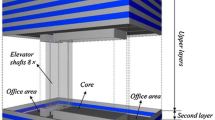Abstract
Natural ventilation mode is a ventilation strategy to control fire-induced hot smoke and provide safe and secure egress routes in subway tunnels. The study was carried out in a 1/15 reduced-scale tunnel using Froude modeling technique to investigate the fire-induced smoke temperature distribution and smoke exhaust through vertical shafts located at the ceiling of the scaled tunnel. A porous bed burner placed on the tunnel floor was used to simulate the fire source and propane was used as the fuel. The temperature distributions under the tunnel ceiling were measured using a series of K-type thermocouples to analyze smoke temperature distribution characteristics. The smoke temperature and velocity in the ventilation shafts were also monitored using hot wire anemometers. The effect of fire size, shaft distance, shaft geometry, train blockage on ceiling temperature distributions and smoke exhaust from shafts were studied. Based on the one-dimensional theory, the ceiling temperature decay characteristics were studied. Finally, empirical equations for predicting ceiling temperature distributions and smoke exhaust in tunnel fires with a natural ventilation mode were derived.










Similar content being viewed by others
Abbreviations
- a :
-
Constant value
- b :
-
Constant value
- c :
-
Constant value
- c p :
-
Heat capacity (kJ/kg/K)
- Fr :
-
Froude number
- g :
-
Gravity acceleration (m/s2)
- H :
-
Tunnel height (m)
- H :
-
Shaft height (m)
- k :
-
Decay coefficient in fire section (m−1)
- k n :
-
Decay coefficient non-fire section (m−1)
- L :
-
Shaft distance (m)
- l :
-
Shaft length (m)
- m :
-
Mass flow rate (kg/s)
- Q :
-
Heat release rate (kW)
- S :
-
Distance from the fire source to the inner boundary of the shaft (m)
- T :
-
Temperature (K)
- V :
-
Volume flow rate (m3/s)
- w :
-
Shaft width (m)
- x :
-
Distance from fire source (m)
- Δ:
-
Difference property between smoke and ambient
- α :
-
Ratio of small-scale to full-scale
- ρ :
-
Density (kg/m3)
- ξ :
-
Local resistance factor
- * :
-
Dimensionless quantity
- 0:
-
Ambient quantity
- m :
-
Small-scale property
- nref :
-
Reference property in non-fire section
- r :
-
Full-scale property
- ref :
-
Reference property in fire section
- s :
-
Smoke property in shaft
References
Vuilleumier F, Weatherill A, Crausaz B (2002) Safety aspects of railway and road tunnel: example of the Lotschberg railway tunnel and Mont-Blanc road tunnel. Tunn Undergr Sp Technol 17:153–158
Carvel RO, Marlair G (2005) A history of fire incidents in tunnels. In: Beard A, Carvel R (eds.) The handbook of tunnel fire safety. Thomas Telford, London, pp 3–41
PIARC (1999) Fire and smoke control in road tunnels. PIARC Committee on Road Tunnels. World Road Association (PIARC), Cedex
Kunsch JP (1998) Critical velocity and range of a fire-gas plume in a ventilated tunnel. Atmospheric Environ 33: 13–24.
Kunsch JP (2002) Simple model for control of fire gases in a ventilated tunnel. Fire Saf J 37: 67–81
Kurioka H, Oka Y (2003) Fire properties in near field of square fire source with longitudinal ventilation in tunnels. Fire Saf J 38: 319–340
Hu LH, Huo R, Chow WK (2008) Studies on buoyancy-driven back-layering flow in tunnel fires. Exp Therm Fluid Sci 32: 1468–1483
Vauquelin O (2005) Parametrical study of the back flow occurrence in case of a buoyant release into a rectangular channel. Exp Therm Fluid Sci 29: 725–731
Li YZ, Lei B, Ingason H (2010) Study of critical velocity and backlayering length in longitudinally ventilated tunnel fires. Fire Saf J 45: 361–370
Carvel RO, Beard AN, Jowitt PW (2001) The influence of longitudinal ventilation systems on fires in tunnels. Tunn Undergr Sp Technol 16: 3–21
Esther K, John PW, Nicholas AD (2008) Fire dynamics simulator (Version 4.0) simulation for tunnel fire scenarios with forced, transient, longitudinal ventilation flows. Fire Technol 44: 137–166
Wang Y, Jiang J, Zhu D (2009) Full-scale experiment research and theoretical study for fires in tunnels with roof openings. Fire Saf J 44: 339–348
Wang Y, Jiang J, Zhu D (2009) Diesel oil pool fire characteristic under natural ventilation conditions in tunnels with roof openings. J Hazard Mater 166: 469–477
Yan T, MingHeng S, YanFeng G, JiaPeng H (2009) Full-scale experimental study on smoke flow in natural ventilation road tunnel fires with shafts. Tunn Undergr Sp Technol 24: 627–633
Schabacker J, Bettelini M (2002) CFD Study of temperature and smoke distribution in a railway tunnel with natural ventilation system. Research Report in HBI Haerter AG
Ingason H, Li YZ (2011) Model scale tunnel fire tests with point extraction ventilation. J Fire Prot Eng 21: 5–36
Li YZ, Ingason H (2012) Position of maximum ceiling temperature in a tunnel fire. Fire Technol 42: 283–302
Quintiere JG (1989) Scaling application in fire research. Fire Saf J 15: 3–29
Karlsson B, Quintiere JG (2000) Enclosure fire dynamics. CRC, Washington
Yuan Z, Lei B, Kashef A (2012) The reduced-scale experimental research on tunnel fire with natural ventilation, in 9th Asia-Oceania symposium on fire science and technology
He Y (1999) Smoke temperature and velocity decays along corridors. Fire Saf J 33: 71–74
Hu LH, Huo R (2005) Full-scale burning tests on studying smoke temperature and velocity along a corridor. Tunn Undergr Sp Technol 20: 223–229
Acknowledgements
This research was supported by the Ministry of Railway of the People’s Republic of China, which is gratefully acknowledged. The authors would also like to thank associate Prof. Zhihao Xu and associate Prof. Zhihui Deng for their assistance in the experiments.
Author information
Authors and Affiliations
Corresponding author
Rights and permissions
About this article
Cite this article
Yuan, Z., Lei, B. & Kashef, A. Experimental and Theoretical Study for Tunnel Fires with Natural Ventilation. Fire Technol 51, 691–706 (2015). https://doi.org/10.1007/s10694-013-0378-x
Received:
Accepted:
Published:
Issue Date:
DOI: https://doi.org/10.1007/s10694-013-0378-x




